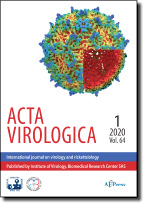Acta Virologica Vol.64, No.4, p.496-500, 2020
|
| Title: Genomic characterization and phylogenetic evolution of the SARS-CoV-2 |
| Author: Rui-Hua Zhang, Xia Ai, Yang Liu, Chun-Hong Li, Hong-Liang Zhang |
|
Abstract: The coronavirus disease 2019 (COVID-19) starting on 12 December 2019 in Wuhan, China, caused 7,885,123 cases including 431,835 deaths by 14 Jun 2020 all over the world. Here we report the genomic characterization and phylogenetic evolution of coronavirus SARS-CoV-2 causing COVID-19. The SARS-CoV-2 and other coronavirus genomes were obtained from GISAID and GenBank. The genomes were annotated and potential genetic recombination was investigated. Phylogenetic analysis was conducted and used to determine the evolutionary history of the virus and to elucidate the origin of the virus. The analysis had revealed that SARS-CoV-2 possessed a similar genomic organization to bat-SARS-like-CoV collected in China. The genome sequences of SARS-CoV-2 were very similar, showing 99.6–100% sequence identity. Notably, SARS-CoV-2 was closely related (with 88% identity) to bat-SARS-like coronavirus, but was more distant from SARS-CoV (about 79%) and MERS-CoV (about 50%). Phylogenetic tree of the complete viral genome showed that the virus clustered with bat SARS-like coronavirus. The results of the similarity between SARS-CoV-2 and related viruses did not identify any potential genomic recombination events. Therefore, it seems that the SARS-CoV-2 might be originally hosted by bats, and might have been transmitted to humans via intermediate hosts of currently unknown wild animal(s). Finally, based on the wide spread of SARS-CoV in their natural reservoirs, future studies should focus more on surveillance of coronaviruses, and measures against the domestication and consumption of wild animals should be implemented.
|
|
| Keywords: coronavirus; SARS coronavirus; SARS-CoV-2; genomic characterization; phylogenetic evolution |
|
|
Published online: 10-Sep-2020
|
| Year: 2020, Volume: 64, Issue: 4 |
Page From: 496, Page To: 500 |
doi:10.4149/av_2020_403
|
|
 download file download file |
|
|
|
|
 download file
download file
